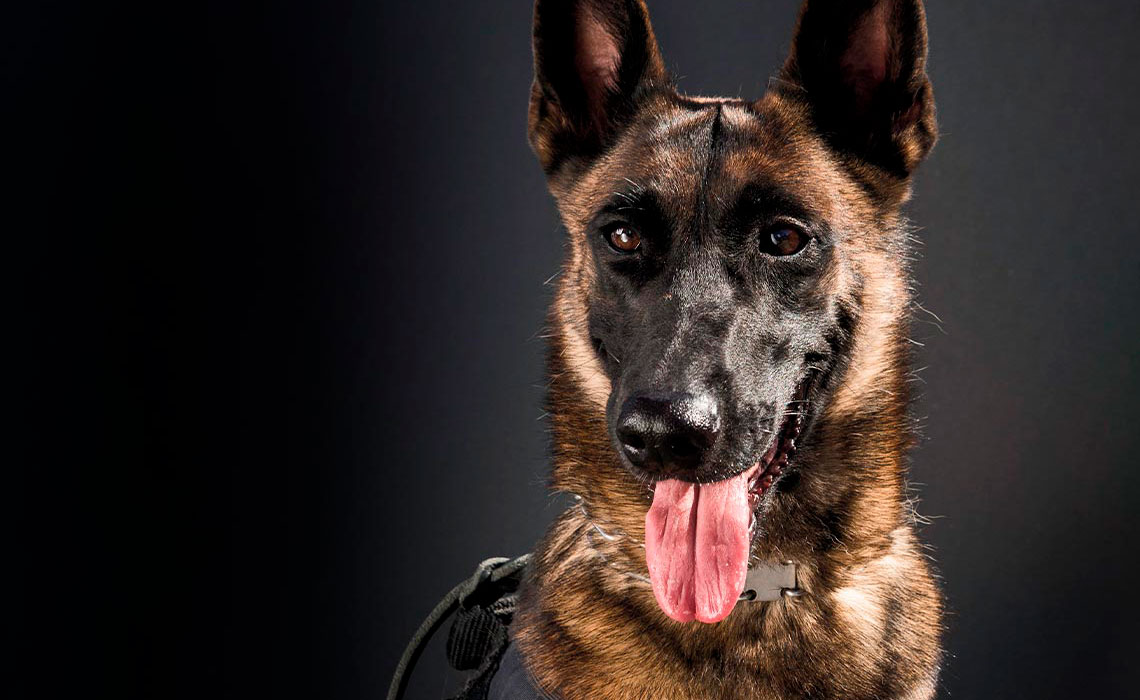The ethical treatment of animals, a concern generally associated with nongovernmental organizations (NGOs) and pet owners (or trainers), is increasingly becoming a priority for researchers. Scientists from different areas of research have dedicated themselves to producing knowledge that would reduce stress and provide a better quality of life for animals, notably those utilized or consumed by humans. This movement has given rise to an interdisciplinary field called animal welfare science. The field includes veterinarians, biologists, psychologists, bioethicists, and other professionals who conduct a variety of studies that range from evaluating the most appropriate conditions for raising and transporting cattle and pigs to handling rats or rabbits used in scientific experiments. Other studies also amplify our understanding of animal pain and cognition, which is essential for measuring degrees of suffering, while other research analyzes the relationships between humans and animals from an ethical perspective.
– The challenge of understanding what animals feel
The origins of the field date back to the 1960s, with activism against cruelty in livestock farming in England (see sidebar) and researchers’ efforts to help address the problem. One major milestone in academia came in the mid-1980s when biologist Donald Broom, now 81, was appointed to create and teach the first animal welfare course at an academic institution, the University of Cambridge, in England. The field’s fundamental principle is the idea that animals are sentient beings, meaning they have the capacity to experience basic sensations and feelings, such as cold and heat, and pain and fear, and can distinguish between pleasant and unpleasant experiences. When they are removed from their natural habitat for purposes of domestication or commercial exploitation, it is the responsibility of humans to ensure their welfare, which includes, according to the canons of this area of knowledge, three ethical concerns: that animals are able to develop their capacities in ways similar to their natural life, do not feel pain or fear, and can experience pleasure and receive the care required to maintain good health.
The movement was given new momentum in the 1990s with the launch of specialized science journals such as Animal Welfare or the Journal of Applied Animal Welfare Science. A glimpse at the most recent issues of these two journals shows the extent to which the field has evolved, with articles produced by researchers from countries the world over, such as Vietnam, Turkey, Brazil, Australia, Mexico, the United Kingdom, and Nigeria, on topics like the welfare of civets (an Asian mammal) raised in captivity on Indonesian coffee plantations. The beans digested and defecated by these mammals produce coffee that sells for US$2,000 per kilogram. Other study subjects range from protocols for breeding sea turtles for research purposes to the reasons why some pet owners in the UK avoid seeking veterinary care, even when free treatment is available. “Today, publications on the subject number in the thousands annually, conferences involve hundreds of researchers, and presentations are not uncommon at gatherings on agriculture, ecology, cognition, and even human emotions,” observes behavioral biologist Georgia Mason, director of the Campbell Centre for the Study of Animal Welfare at the University of Guelph in Canada, in an article published six months ago in BMC Biology.
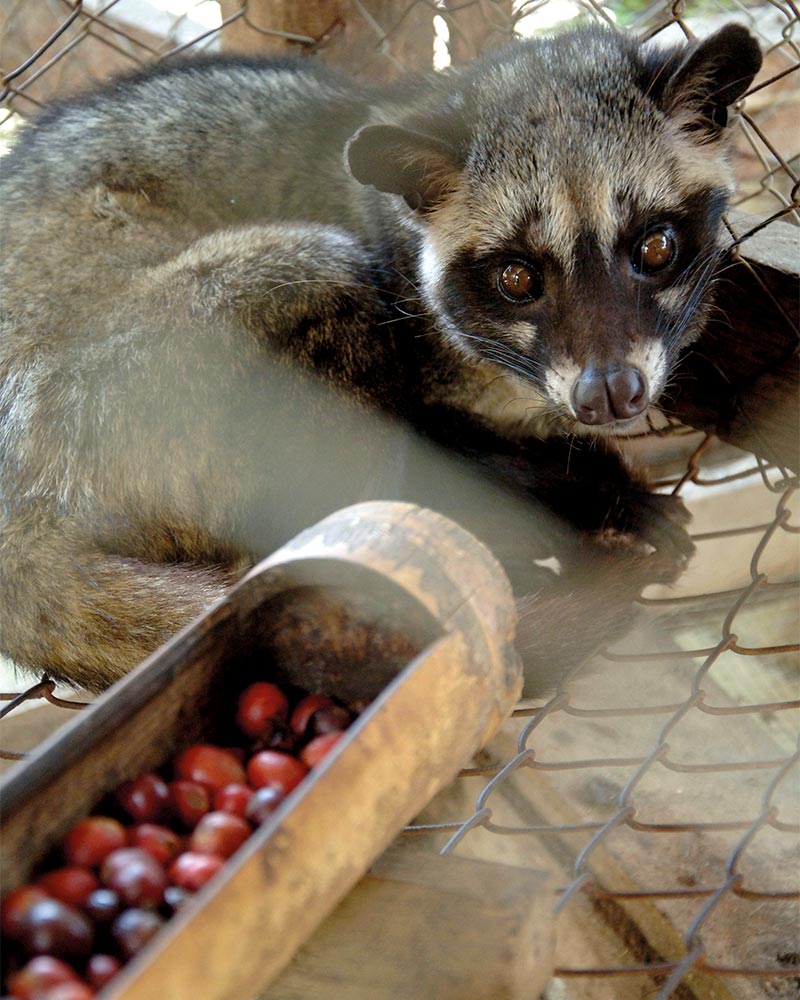
Captive-bred civet in Thailand: studies have investigated the welfare of civets, a mammal that digests and defecates high-value coffee beansArief Priyono / LightRocket via Getty Images
Researchers’ efforts to prevent animals from being subjected to cruelty come as a response to pressure from citizens and consumers and to national legislation, but most research also targets interests such as increasing productivity and sustainability in meat production. In countries like Brazil, Uruguay, and Argentina — all major meat exporters — common issues include losses in production, shipment, transportation, and handling in slaughterhouses, which not only cause suffering but also affect competitiveness in livestock farming. A study published in 2021 by animal scientist Mateus José Rodrigues Paranhos da Costa, a researcher at the School of Agricultural and Veterinary Sciences at São Paulo State University (UNESP), Jaboticabal campus, defined parameters for the number of pigs allocated in trucks when transported to slaughterhouses.
The study concluded that load densities below 235 kilograms per square meter (kg/m²) allow piglets enough space to travel more comfortably and arrive at the slaughterhouse less fatigued and bruised. This is equivalent to a density of just over two pigs per square meter (each pig weighs around 100 kilos at the time of slaughter.) “In Brazil, it is estimated that over 10 million kilos of meat are discarded annually due to bruised carcasses caused by falls, bumps, and slips that could be avoided with more careful handling,” says Paranhos da Costa. The study evaluated the conditions of nearly 2000 transported pigs. Injury rates were much higher at a pig density of 270 kg/m² compared to lower animal densities of 240 and 200 kg/m².
Agronomist Alex Maia, also from UNESP’s Jaboticabal campus, and currently a visiting researcher at the University of Idaho in the United States, studies the role of thermal comfort in improving quality of life for cattle. Each year, Brazil fattens approximately 7 million beef cattle in open feedlots with no protection against the environment, including exposure to solar radiation, particularly ultraviolet rays (see Pesquisa FAPESP issue nº 340). “It’s a very uncomfortable environment for the animals, inconvenient for producers, and a challenge for the industry because society today has a critical view of systems that seek high profits at the expense of animal quality of life,” Maia says. Working in partnership with the Campanelli Innovation Center of the Agropastoral Paschoal Campanelli group at the Santa Rosa ranch in Altair, 419 kilometers from São Paulo, Maia is developing a concept called “smart shade.” The rectangular feedlot features a metal structure and steel cables that suspend tiles that provide shade over 20% of the total area at any time of day, protecting the entire herd from direct solar radiation.
Experiments were conducted with over 6,000 beef cattle, mostly from the Nelore breed, which were given the freedom to choose between sun exposure or shade. Some of these results were published in 2023 in Frontiers in Veterinary Science. On average, cattle in shaded pens gained 5 to 10 kg more carcass weight, depending on the breed, compared to cattle managed in unshaded pens. From an environmental point of view, another notable result was water consumption. On average, cattle in smart shade pens drank about 10 liters less water per day compared to those without shade. Based on his research data, Maia is developing artificial intelligence models in the United States that can predict dry feed and water consumption, as well as weight gain, based on a herd’s exposure to solar radiation.
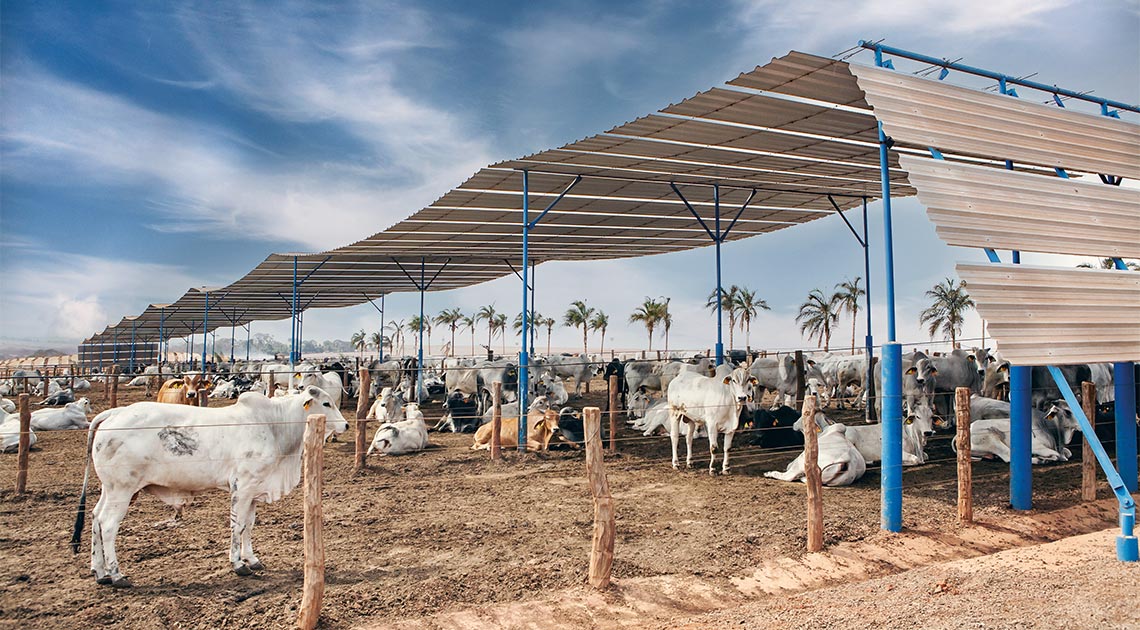
A “smart shade” corral at the Santa Rosa farm, in Altair, São Paulo State, provides for greater thermal comfort and lower water consumptionCampanelli Innovation Center
The scientists’ agenda may seem to align with those of animal protection organizations, but their objectives differ. From the NGOs’ perspective, almost any utilization of animals is ethically unacceptable, while researchers’ focus is on providing animals with dignified and painless treatment and trying to reduce their use whenever possible, as in animal experimentation. However, this approach by some scientists is not uncontentious and often involves — at times — heated ethical debates. Veterinarian Carla Molento from the Federal University of Paraná (UFPR) considers it essential to evaluate whether research and new technologies on animal welfare genuinely aim to improve their living conditions, even in a production setting, or if the real goal is to increase producer profits. “Often, there’s a kind of deception going on. A study presents itself as animal welfare research, but its true purpose is to improve productivity,” says Molento, who leads the Animal Welfare Laboratory (LABEA) at UFPR — the first Brazilian research center that included the term “animal welfare” in its name, in 2004.
In a study her group published in 2023 in the journal Animals, Molento and her collaborators selected 180 science articles that included “animal welfare” or “animal well-being” in their objectives or hypotheses. Five evaluators scored the articles on a scale of 1 to 10 based on the intrinsic value attributed to animals. In journals that primarily focus on production, the average score was 4.74 points, while those in animal welfare journals averaged 6.46. “The low overall scores highlight that welfare publications are not, on average, prioritizing animal interests,” Molento wrote. She proposes that scientific studies in this area include an explicit statement regarding researchers’ motivations and interests to assess whether animals are treated as a priority.
Laboratory animals
Scientific experimentation is another important focus of animal welfare science. Ensuring that lab animals lead healthy, pain-free lives is essential for them to fulfill their intended purpose of generating data to advance knowledge or test new drug pathways. “Besides being intolerable for society to keep animals in unhealthy conditions, it can create biases in research results,” explains veterinarian Luisa Maria Gomes de Macedo Braga, president of the National Council for the Control of Animal Experimentation (CONCEA), an agency linked to the Ministry of Science, Technology, and Innovation (MCTI) that is responsible for formulating and ensuring compliance with operational standards for facilities where animals are raised and utilized.
CONCEA was created by Federal Law No. 11,794, enacted in October 2008, which proposed procedures and standards for the use of animals in research in Brazil. It is better known as the Arouca Law, in reference to its author, the public health expert and federal representative Sérgio Arouca (1941–2003), president of the Oswaldo Cruz Foundation (FIOCRUZ) from 1985 to 1989. The law also mandated that each research institution must have an Ethics Committee on Animal Use (CEUA) responsible for evaluating projects using lab animals and ensuring they are used in the smallest possible number, in dignified conditions, and with minimal suffering.
The CONCEA resolutions changed the landscape of animal experimentation in Brazil. Most recently, they mandated the replacement of animal use with alternative methods in the quality control of products and medications. Among the technologies looking to replace animal use in cosmetic testing, one of the most promising is known as body-on-a-chip (BOC), based on 3D printing of human tissues such as skin and intestines (see Pesquisa FAPESP issue nº 335). The resolutions also had an impact on the application of public policies. A group of 120 Brazilian researchers, mostly coordinated by CONCEA members, worked over the last 10 years to produce the Brazilian Guide for the Production, Maintenance, and Use of Animals for Teaching or Scientific Research Activities, a 1,100-page manual that provides guidelines on facilities, care, and management.
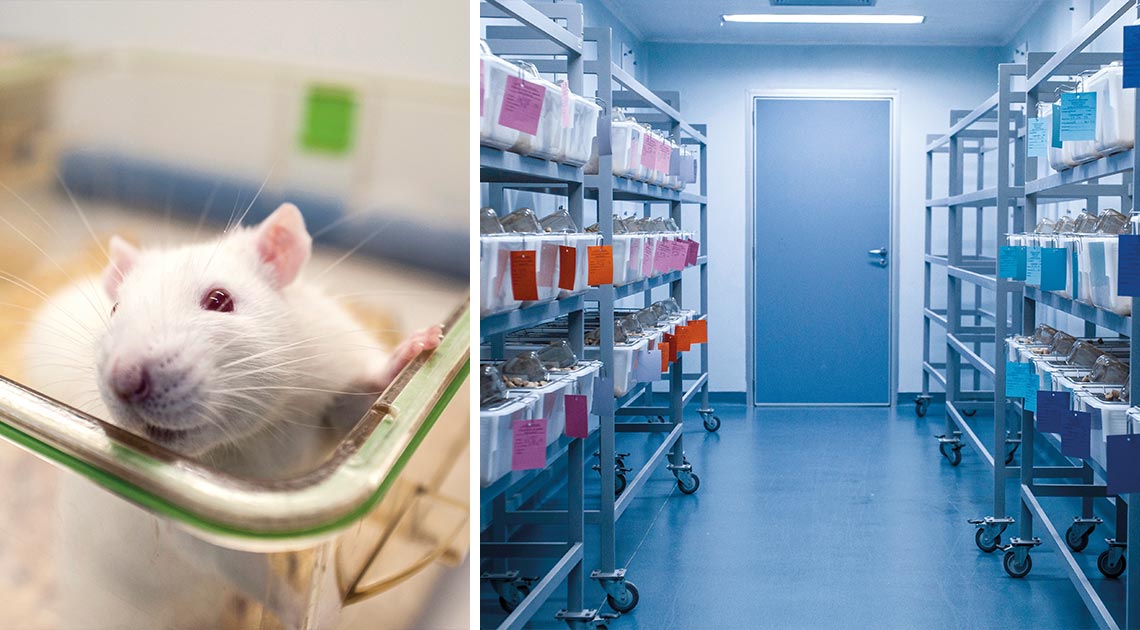
A rodent raised in a vivarium at USP: teachers and technicians have access to a training course in ethical principles and animal managementLéo Ramos Chaves / Revista Pesquisa FAPESP
The guide defines in detail how rodents, rabbits, dogs and cats, monkeys, ruminants, fish, pigs, birds, and other animals used in scientific experiments should be raised. It includes specifications on how to structure vivaria and other research facilities — without which they cannot be licensed — from the minimum space to be reserved for each species to requirements for exclusive areas for quarantine. It also proposes protocols to reduce animal pain and stress, such as environmental noise levels, the size of needles used for anesthesia, or the type of training professionals conducting these experiments should receive (see Pesquisa FAPESP issue nº 328).
The impact of the first 15 years of the Arouca Law’s implementation is being evaluated by a team led by veterinarian José Luiz Jivago de Paula Rôlo from the University of Brasília (UnB). One of the data points the group has analyzed is the number of articles by Brazilian authors that use the term “animal welfare” and reference some type of regulation related to the use of animals in research projects. Until the 1990s, the number of papers was quite low — at most five per year — but grew exponentially beginning in the mid-2000s. In 2020 alone, there were over 200 articles citing the CONCEA regulations and guidelines. The survey, expected to be completed by the end of the year, will also map research groups working with the topic in Brazil. “We can already state that there are two major trends. There are teams focused on experimentation and those dedicated to studies on livestock animals. And this second group is larger,” says Rôlo.
The two aspects of research often intertwine. Veterinarian Helder Louvandini, from the Center for Nuclear Energy in Agriculture at the University of São Paulo (CENA-USP), in Piracicaba, participated in one of the teams that produced the CONCEA manual. He helped systematize standards for research with large ruminants, such as cattle and buffalo, establishing guidelines from calf rearing to detailed parameters for confinement systems, such as the use of nonslip floors and ventilation systems. Louvandini says that the issue of animal welfare became an inseparable part of his studies on nutrition. “I coordinate a project supported by FAPESP whose goal is validating the use of zinc oxide nanoparticles as a functional feed for ruminants. The goal is not only to improve the animals’ nutritional conditions but also to analyze the effect on parasite control, which is a fundamental parameter for their welfare. All research aimed at enhancing sustainability in production ends up having a connection with animal welfare,” he says.
One of the pioneers in animal welfare science in Brazil is veterinarian Adroaldo José Zanella from Rio Grande do Sul. He coordinates the Center for Comparative Studies in Health, Sustainability, and Animal Welfare at the School of Veterinary Medicine and Animal Science (FM-VZ) at USP, Pirassununga campus, and leads research on beef and dairy cattle, sheep, and, in particular, pigs. A recent article his research group published in April in Nature Food mapped sustainability and welfare indicators in the pig supply chain in Brazil and the United Kingdom. The study compared data on 74 pig farms in the United Kingdom and 17 in Brazil. One of its most important findings indicates that there is higher use of antimicrobials among pigs raised in compromised welfare conditions. “These drugs are used in smaller quantities when welfare indicators are better,” he says. Zanella, who has supervised the training of over 30 master’s and 25 doctoral students, envisions a multidisciplinary approach to advance research, integrating lawyers, doctors, philosophers, educators, and professionals from the exact sciences, especially those connected to artificial intelligence. “Our group is trying to find people in the humanities who can help us understand, for example, ways to improve how the labor force works with animals,” he says.
Zanella earned his PhD in animal welfare from the University of Cambridge in 1992, with the pioneering scientist Broom as his advisor. His thesis focused on the welfare indicators of sows during pregnancy, still one of the main focuses of his research center. In his thesis, he identified a neurophysiological marker associated with repetitive behavior in pigs, which is similar to the behavior developed by some people with autism. In other studies his group published in the journal Brain Research, data demonstrated that when subjected to social isolation or premature weaning the species suffers from anxiety, increased aggressive behavior, memory problems, and impairments in brain areas responsible for emotion modulation and cognitive processes. In another recent article Zanella published in the journal Frontiers in Animal Science, he showed that even when they never came into contact with their fathers, piglets sired by males held in pens for four weeks showed more fear and anxiety, with elevated cortisol levels in their saliva, when exposed to unfamiliar stressful encounters. These same questions have been evaluated in sheep and goats, with similar results.
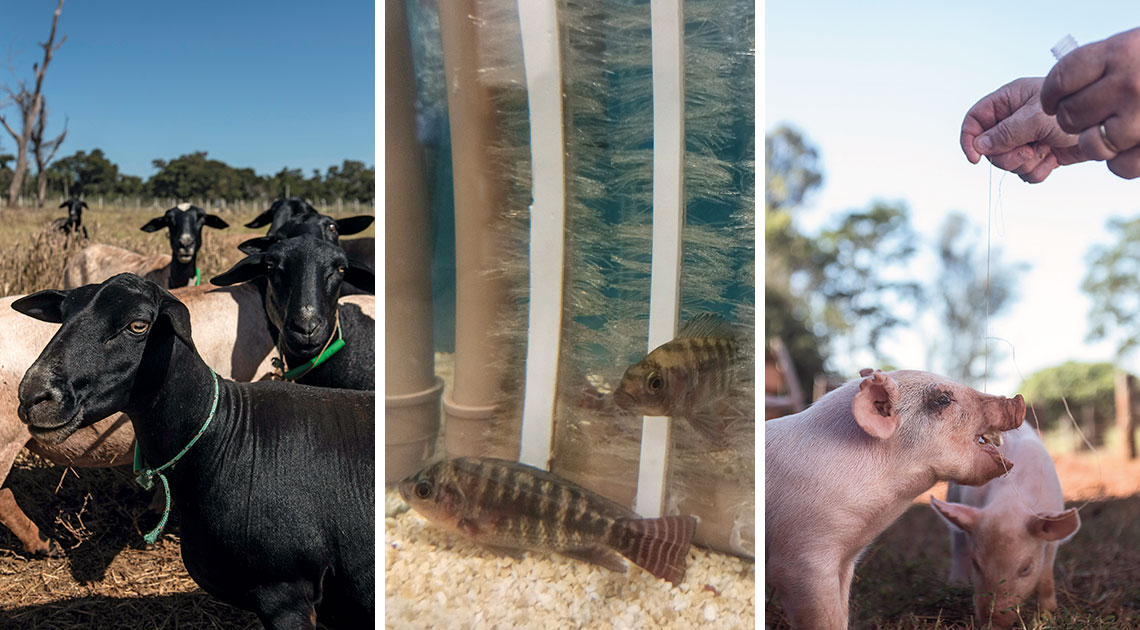
Sheep and noninvasive collecting of oral fluid from pigs, both at USP’s Pirassununga campus. Tilapia are massaged by bristles in an aquarium at UNESPLéo Ramos Chaves / Revista Pesquisa FAPESP | Ana Carolina dos Santos Gauy
Although there has been a prevalence of studies focused on livestock, there are now research projects on many other species being conducted in Brazil. Researchers from UnB support federal government agencies, such as the Ministry of Agriculture and Livestock, the Federal Police, and the Federal Revenue Service, which use dogs with exceptional olfactory abilities to sniff out drugs, explosives, and food, helping the agencies define protocols for ensuring animal welfare. The dogs, which can cost up to R$60,000 each, can experience decreased performance at executing tasks when subjected to exhausting or very adverse conditions.
“An animal’s maximum potential is reached when it feels comfortable, well-fed, and hydrated. There are a series of welfare parameters, such as working hours and rest breaks that need to be followed,” explains veterinarian Cristiano Barros de Melo, a professor at UnB who teaches a course on Dogs in the interest of Public Service in the university’s postgraduate animal sciences program. Melo also provides animal science training to business owners and public officials working with dogs. “For the dogs, sniffing work is an enjoyable game. If they see the work as a big game, their skills are put to good use. When they sniff at a high-performance level, their mouths must stay closed so they can breathe through their nostrils to do the work. This is why it’s necessary to calibrate their work efforts.”
In a study published in May in the journal Frontiers in Veterinary Science, Melo’s research group evaluated the performance of Federal Revenue dogs working in drug seizures between 2010 and 2020 at borders, airports, ports, and mail receiving centers in real-world situations around Brazil. In that period, 977,000 kilos of marijuana and 179,300 kilos of cocaine, among other narcotics were seized. The study concluded that with each new dog introduced into the inspection system there was an increase of more than three tons of drugs seized.
There are also other studies still in earlier stages of investigation. Zoologist Eliane Gonçalves de Freitas, from the Animal Behavior Laboratory at UNESP’s São José do Rio Preto campus, is studying how body tactile stimulation, a remedy used to reduce stress in various species, can improve the welfare of tilapia. In two articles, one published in 2019 and another in 2022 in the journal Scientific Reports, her group analyzed the behavior of tilapia raised in aquariums. In order to reach their feeding area, the fish were directed through a column of soft silicone bristles that gently massaged their bodies. Although the stimulation did not have an impact on cortisol—a hormone associated with stress when its levels are elevated — the tilapia in the massage experiment showed less aggressiveness in interactions with others.
They also observed that the fish grew more rapidly while consuming less feed, which was attributed to the energy saved from reduced fighting. In a project supported by FAPESP, in partnership with researchers from the University of Porto, Portugal, and the Technical University of Denmark, Freitas is now investigating whether tilapia voluntarily seek out the massage when not directed to pass through the bristles, while also investigating certain neural mechanisms involved with the response to tactile stimulation. She is also analyzing the effect of the massage on three other aggressive ornamental fish species and whether the effects can be duplicated in marine species of interest in European aquaculture, such as the gilthead seabream (Sparus aurata) and white seabream (Diplodus sargus). “The number of studies on fish welfare is still low; the field only began to emerge in this century. There is evidence that they feel pain, but there are still few studies on how to reduce suffering,” she observes. One of the challenges of animal welfare science, Freitas notes, is to expand its scope to species that currently do not attract much attention from researchers, either because they don’t inspire compassion in humans or because they lack commercial interest.
A 1960s book exposed overcrowded pens in the UK
In 1964, English activist Ruth Harrison opened Pandora’s box regarding cruelty in animal production when she published Animal Machines. In the 186-page book, which has not been translated into Portuguese, she compared the stark contrast between idyllic farms with their lichen-covered barns and cows called by their own names to the “awkward” warehouse barns where — even then — producers were already applying antibiotics and hormones to animals and confining them in overcrowded pens to transform them into commodities. The book had a significant impact. In June that same year, the British government appointed zoology professor Francis William Rogers Brambell from Bangor University to lead a team of investigators and provide a technical response to the issue. Was the book an exaggeration, or was the intensive production system truly causing animal suffering?
In December 1965, the group, later called the Brambell Committee, released an 85-page report acknowledging that animals could experience physical pain and emotions such as fear, anger, apprehension, frustration, and pleasure. The report also emphasized the importance of the animal’s freedom of movement, defined in five “freedoms”: to stand up, lie down, turn around, groom themselves, and stretch their limbs. Given the lack of research on the subject, the committee proposed that scientists focus their studies on animal welfare to better define the term and develop indices and parameters to better evaluate and measure the living conditions of animals, especially those raised for food. Thus was the doorway opened to the science of animal welfare.
Courses provide training on ethical principles and handling in animal experimentation
In 2017, the National Council for Scientific and Technological Development (CNPq) announced a competitive bid for proposals to provide courses and training for teachers, technicians, veterinarians, and students working in animal experimentation facilities. The team led by biologist Patrícia Gama, the director of the Institute of Biomedical Sciences at the University of São Paulo (ICB-USP) and coordinator of the USP Vivarium Network, had a project selected for funding. The result was the creation of a distance learning extension course on ethical principles and animal management, which trained over 10,000 professionals. “We classified the program as an extension course, a category that allowed us to include people without a full education, since many research institution employees have not completed high school,” Gama explains. She developed the program with Claudia Cabrera Mori from the School of Veterinary Medicine and Animal Science at USP, together with another group of veterinarians already working at the institution.
In the first round, from 2018 to 2021, 10,726 people were selected, of which 6,418 completed the course. In the second round, from 2021 to 2022, 7,914 were selected and 4,895 completed the training. In response to a request from CONCEA that mandatory training be extended to include care for animals other than rats and mice, such as cattle, birds, and fish, the USP team launched a course on ethical principles and animal handling with separate training modules for these species in March 2023. As of January this year, 4,559 of the 10,813 enrolled students had completed this course. “In practice, we’re already seeing changes in behavior,” says Gama. She observes that the improved quality of training, and of the facilities themselves, has meant that fewer animals are used per scientific experiment, which is also reflected in the dissemination of research results.
Projects
1. Animal welfare as added value in livestock production chains (nº 23/12374-4); Grant Mechanism Organization Grant ‒ Scientific Meeting; Principal Investigator Mateus José Rodrigues Paranhos da Costa (UNESP); Investment R$96,605.44.
2. Tactile body stimulation and well-being in fish: Effects on aggression, brain monoamines, and productive performance (nº 23/02306-1); Grant Mechanism Regular Research Grant; Principal Investigator Eliane Gonçalves de Freitas (UNESP); Investment R$273,424.42.
3. Zinc oxide nanoparticle as functional food (nº 19/26042-8); Grant Mechanism Thematic Project; Principal Investigator Helder Louvandini (USP); Investment R$2,528,542.97.
4. Epigenetic consequences of experience in the pre-copulation period of male pigs on the cognition and emotionality of piglets (nº 20/00826-0); Grant Mechanism Research Grant ‒ Sprint; Agreement Linköping University (LiU) Principal Investigator Adroaldo Jose Zanella (USP); Investment R$32,630.38.
5. Using photovoltaic panels to create shade for beef cattle: A study of thermal balance, economic viability, and environmental impact (nº 18/19148-1); Grant Mechanism Research Grant ‒ Program for Research on Global Climate Change; Principal Investigator Alex Sandro Campos Maia (UNESP); Investment R$208,086.17.
6. The contribution of males to the development of robust phenotypes and the mitigating role of the welfare of female pigs (nº 18/01082-4); Grant Mechanism Regular Research Grant; Principal Investigator Adroaldo Jose Zanella (USP); Investment R$222,973.53.
Scientific articles
MASON, G. J. Animal welfare research is fascinating, ethical, and useful ‒ but how can it be more rigorous? BMC Biology. vol. 21, nº 302. 2023.
URREA, V. M et al. Behavior, blood stress indicators, skin lesions, and meat quality in pigs transported to slaughter at different loading densities. Journal of Animal Science. vol. 99. ed. 6. 2021.
MAIA, A. S. C et al. Economically sustainable shade design for feedlot cattle. Frontiers in Veterinary Science. vol. 10. 2023.
FRAGOSO, A. A. et al. Animal Welfare Science: Why and for Whom? Animals. vol. 13. p. 1833. 2023.
BARTLET, H. et al.Trade-offs in the externalities of pig production are not inevitable. NatureFood. vol. 5. pp. 312–22. 2024.
ZANELLA, A. J. et al.Effects of early weaning and social isolation on the expression of glucocorticoid and mineralocorticoid receptor and 11β-hydroxysteroid dehydrogenase 1 and 2 mRNAs in the frontal cortex and hippocampus of piglets. Brain Research. vol. 1067. pp. 36–42. 2006.
ZANELLA, A. J. et al.Inheriting the sins of their fathers: Boar life experiences can shape the emotional responses of their offspring. Frontiers in Animal Science. vol. 4. 2023.
MELO, C. B. et al.Detection dogs fighting transnational narcotraffic: Performance and challenges under real customs scenario in Brazil. Frontiers in Veterinary Science. vol. 11. 2024.
BOLOGNESI, M. C et al. Tactile stimulation reduces aggressiveness but does not lower stress in a territorial fish. Scientific Reports. vol. 9, no. 40. 2019.
GAUY, A. C et al. Long-term body tactile stimulation reduces aggression and improves productive performance in Nile tilapia groups. Scientific Reports. vol. 12, no. 20239. 2022.
